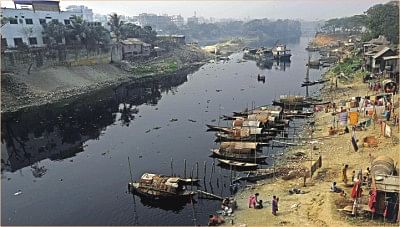Tk 21cr goes down rivers

People wash dishes in pitch-black water of the Turag to the west of Tongi Bridge in Dhaka while a government drive to remove sludge from the riverbed continues, hardly achieving anything as the sources of pollution have not been stopped.Photo: Anisur Rahman
Though the government has already spent over Tk 21 crore on its much-hyped Buriganga-Turag River Cleaning Project, the rivers remain contaminated with toxic wastes, as the pollution sources could not be plugged.
In recent water quality tests, the Department of Environment found the amount of dissolved oxygen, which determines the degree of pollution, is still too low for aquatic lives to survive in the Buriganga.
"The water quality is not good yet because we couldn't stop the sources of liquid waste," said Abdus Sobhan, deputy director general of DoE.
Hazaribagh tanneries are still there, he said adding that excreta of millions of city dwellers are still emptying into the rivers through Wasa storm sewers every day.
With the river pollution continuing unabated, the dependence on groundwater grows.
Around 85 percent of the city's water demand is met from below the ground, as most of the surface water is contaminated. This heavy reliance on groundwater causes the water table to lower three to four metres a year, said sources in Dhaka Water and Sewerage Authority (Wasa).
It was to solve this scarcity of safe surface water the government undertook the Buriganga-Turag River Cleaning Project.
Bangladesh Inland Water Transport Authority began implementing the first phase of the project in May last year, and has already spent over Tk 21 crore.
BIWTA was supposed to clean three kilometres of the Buriganga from Babubazar to Kamrangirchar and one kilometre of the Turag in Tongi.
It is spending Tk 285 to dredge and grab per cubic metre of garbage from the riverbed and more than that to collect the floating and solid waste from the riverbank.
"We know the project is not yielding satisfying results. And that's why we are going slower now," said a BIWTA official requesting anonymity.
Asked then why they are spending public money, the official replied, "Tk 21.5 crore has already been allocated for this project. So we are just continuing with the work."
According to the project proposal, the riverbeds in the capital are clogged with thick layers of polythene, coconut shells, plastic, mud and bricks.
Two metres from the edge of the riverbeds and one metre from the middle need to be excavated, says the project proposal, which was funded from the climate change trust funds generated by government revenue.
In December last year, the DoE collected samples from five different points along the Buriganga for determining the quality of the river water.
Laboratory analysis of the samples shows that presence of dissolved oxygen was between 0.50-0.84 mgs per litre (mg/L), while standard surface water is 5 mg/L in Bangladesh.
Besides, pH, a measure of the acidity, was identified to be between 7 and 7.5.
The standard DO requirement for fish and other aquatic lives is 5 mg/L and pH requirement is 6.5 as per the set standard in Bangladesh.
Earlier, researchers from Bangladesh University of Engineering and Technology (Buet) found that oxygen levels were 0.7 and 0.25 at Chadnighat point, 0.27 and 0.63 in Norai near Trimohini, and 0.27 and 0.63 in the Turag at Tongi before and after the monsoon respectively.
A three-year research finds that some invertebrates and small organisms come to life in these rivers when water flow increases in the rains. But these life forms disappear in the dry season, the researchers add.
The Institute of Water Modelling (IWM) and the World Bank conducted a survey of pollution in Dhaka rivers in 2007 that showed there are over 300 various effluent discharge outlets in the capital and Narayanganj.
Of these, 19 outlets carry mixed flows of industrial and household waste into the rivers around the capital.
The study also observed that the groundwater system is being contaminated more in areas where aquifers are recharged from the riverbeds.
Over 300 major industrial units are still dumping their liquid waste into the rivers, say DoE officials.
Things have not changed much despite DoE drives against pollution. The environmental watchdog has so far fined over 100 industries for not installing Effluent Treatment Plant (ETP), which is mandatory as per the law.
DoE Deputy Director General Sobhan, also a member of the project's monitoring committee, suggests continuing with the project. He said, "If they remove one cubic metre of garbage from the river, space for one cubic metre of water will increase."
Besides, he added, measures should be taken to stop dumping of human excreta into the rivers.

 For all latest news, follow The Daily Star's Google News channel.
For all latest news, follow The Daily Star's Google News channel. 



Comments